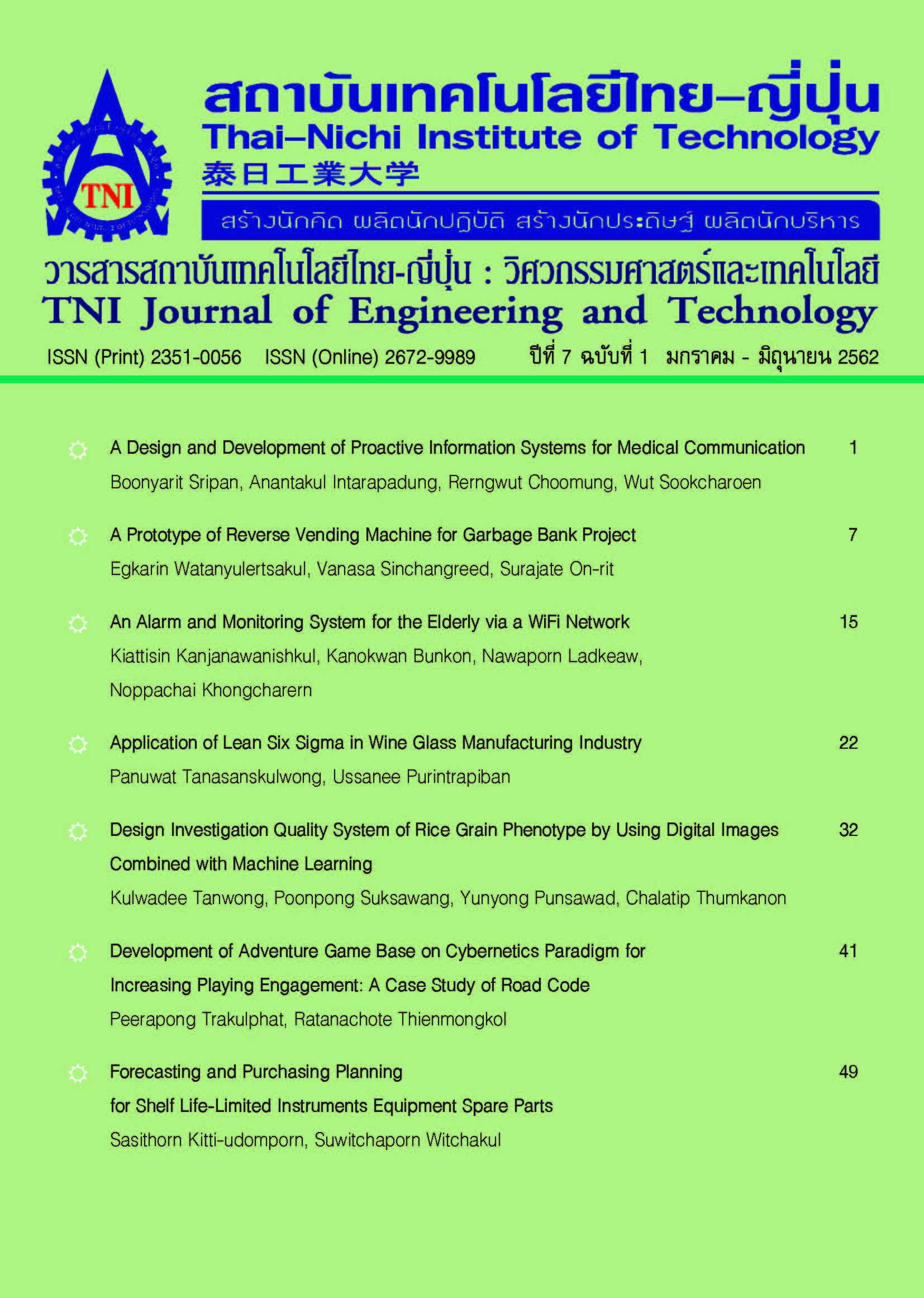ระบบเฝ้าติดตามและแจ้งเตือนสำหรับผู้สูงอายุโดยทางเครือข่ายวายฟาย
Main Article Content
บทคัดย่อ
แนวโน้มของสัดส่วนอายุของประชากรทำให้ประเทศไทยกำลังก้าวเข้าสู่สังคมผู้สูงอายุอย่างเต็มรูปแบบ ปัญหาที่สำคัญปัญหาหนึ่ง คือ ผู้สูงอายุถูกทิ้งให้อยู่ตามลำพัง ซึ่งนำไปสู่อุปสรรคในการดำรงชีวิตหลายอย่าง เช่น อุบัติเหตุในผู้สูงอายุที่เกิดจากการพลัดตกหกล้ม ดังนั้น วัตถุประสงค์ของโครงการวิจัยนี้ คือ (1) สร้างระบบเฝ้าติดตามและแจ้งเตือนสำหรับผู้สูงอายุ เมื่อผู้สูงอายุประสบอุบัติเหตุหรือเจ็บป่วย และ (2) พัฒนาเครือข่ายวายฟายภายในที่อยู่อาศัย ซึ่งทำหน้าที่เชื่อมต่อการส่งข้อมูลระหว่างอุปกรณ์ตรวจจับไร้สาย ไปยังบอร์ด Raspberry Pi ซึ่งทำหน้าที่เป็นตัวประมวลผลหลัก อุปกรณ์ตรวจจับไร้สายที่ใช้ในการตรวจจับสถานการณ์ผิดปกติและฉุกเฉิน ได้แก่ ชุดตรวจจับการล้มด้วยเซ็นเซอร์วัดความเร่ง ชุดตรวจจับการเคลื่อนไหวด้วยกล้องและเซ็นเซอร์วัดระยะทาง และ ชุดปุ่มฉุกเฉิน หากเกิดเหตุการณ์ตามเงื่อนไขที่กำหนด นั่นคือ การล้ม หรือ การกดปุ่มฉุกเฉิน หรือ ไม่มีการเคลื่อนไหวภายในช่วงเวลาที่กำหนด บอร์ด Raspberry Pi จะส่งข้อความแจ้งเตือนในรูปแบบข้อความสั้นทางโทรศัพท์ไปยังผู้ดูแลอย่างอัตโนมัติ ผลการทดลองพบว่า ระบบเฝ้าติดตามและแจ้งเตือน ทำงานได้ตามวัตถุประสงค์ที่ตั้งไว้ทั้งในกรณีจำลองสถานการณ์และใช้งานจริง
Article Details
นโยบายการรับบทความ
กองบรรณาธิการวารสารสถาบันเทคโนโลยีไทย-ญี่ปุ่น มีความยินดีรับบทความจากอาจารย์ประจำ และผู้ทรงคุณวุฒิในสาขาวิศวกรรมศาสตร์และเทคโนโลยี ที่เขียนเป็นภาษาไทยหรือภาษาอังกฤษ ซึ่งผลงานวิชาการที่ส่งมาขอตีพิมพ์ต้องไม่เคยเผยแพร่ในสิ่งพิมพ์อื่นใดมาก่อน และต้องไม่อยู่ในระหว่างการพิจารณาของวารสารอื่นที่นำส่ง ดังนั้นผู้สนใจที่จะร่วมเผยแพร่ผลงานและความรู้ที่ศึกษามาสามารถนำส่งบทความได้ที่กองบรรณาธิการเพื่อเสนอต่อคณะกรรมการกลั่นกรองบทความพิจารณาจัดพิมพ์ในวารสารต่อไป ทั้งนี้บทความที่สามารถเผยแพร่ได้ประกอบด้วยบทความวิจัย ผู้สนใจสามารถศึกษาและจัดเตรียมบทความจากคำแนะนำสำหรับผู้เขียนบทความ
การละเมิดลิขสิทธิ์ถือเป็นความรับผิดชอบของผู้ส่งบทความโดยตรง บทความที่ได้รับการตีพิมพ์ต้องผ่านการพิจารณากลั่นกรองคุณภาพจากผู้ทรงคุณวุฒิและได้รับความเห็นชอบจากกองบรรณาธิการ
ข้อความที่ปรากฏภายในบทความของแต่ละบทความที่ตีพิมพ์ในวารสารวิชาการเล่มนี้ เป็น ความคิดเห็นส่วนตัวของผู้เขียนแต่ละท่าน ไม่เกี่ยวข้องกับสถาบันเทคโนโลยีไทย-ญี่ปุ่น และคณาจารย์ท่านอื่น ๆ ในสถาบัน แต่อย่างใด ความรับผิดชอบด้านเนื้อหาและการตรวจร่างบทความแต่ละบทความเป็นของผู้เขียนแต่ละท่าน หากมีความผิดพลาดใด ๆ ผู้เขียนแต่ละท่านจะต้องรับผิดชอบบทความของตนเองแต่ผู้เดียว
กองบรรณาธิการขอสงวนสิทธิ์มิให้นำเนื้อหา ทัศนะ หรือข้อคิดเห็นใด ๆ ของบทความในวารสารสถาบันเทคโนโลยีไทย-ญี่ปุ่น ไปเผยแพร่ก่อนได้รับอนุญาตจากผู้นิพนธ์ อย่างเป็นลายลักษณ์อักษร ผลงานที่ได้รับการตีพิมพ์ถือเป็นลิขสิทธิ์ของวารสารสถาบันเทคโนโลยีไทย-ญี่ปุ่น
ผู้ประสงค์จะส่งบทความเพื่อตีพิมพ์ในวารสารวิชาการ สถาบันเทคโนโลยีไทย-ญี่ปุ่น สามารถส่ง Online ที่ https://www.tci-thaijo.org/index.php/TNIJournal/ โปรดสมัครสมาชิก (Register) โดยกรอกรายละเอียดให้ครบถ้วนหากต้องการสอบถามข้อมูลเพิ่มเติมที่
- กองบรรณาธิการ วารสารสถาบันเทคโนโลยีไทย-ญี่ปุ่น
- ฝ่ายวิจัยและนวัตกรรม สถาบันเทคโนโลยีไทย-ญี่ปุ่น
เลขที่ 1771/1 สถาบันเทคโนโลยีไทย-ญี่ปุ่น ซอยพัฒนาการ 37-39 ถนนพัฒนาการ แขวงสวนหลวง เขตสวนหลวง กรุงเทพมหานคร 10250 ติดต่อกับคุณพิมพ์รต พิพัฒนกุล (02) 763-2752 , คุณจุฑามาศ ประสพสันติ์ (02) 763-2600 Ext. 2402 Fax. (02) 763-2754 หรือ E-mail: JEDT@tni.ac.th
เอกสารอ้างอิง
Office of the National Economic and Social Development Council, Population projection for Thailand 2010 – 2040. (In Thai). Bangkok : Office of the National Economic and Social Development Council, 2013.
Y.S. Delahoz and M.A. Labrador, “Survey on fall detection and fall prevention using wearable and external sensors,” Sensors, vol. 14, no. 10, pp. 19806–19842, 2014.
S. Eamsamai, R. Mhuansit and C. Thongmag, “An elderly care model among caregiving volunteers at Phukrang municipality, Amphur Praputthabat, Saraburi province,” (In Thai). Nursing Journal of the Ministry of Public Health, vol. 22, no. 3, pp. 77-87, 2012.
T. Yu, A. Stamm and R. Hartanto, “Design and implementation of a Bluetooth low energy-based local area network for fall detection,” in Proc. 12th Conference of the International Sports Engineering Association, Queensland, Australia, March 26-29, 2018.
Y. Lee, H. Yeh, K. Kim and O. Choi, “A real-time fall detection system based on the acceleration sensor of smartphone,” International Journal of Engineering Business Management, vol. 10, pp. 1–8, 2018.
C. Ko, F. Leu and I. Lin, “A wandering path tracking and fall detection system for people with dementia,” in Proc. 9th International Conference on Broadband and Wireless Computing, Communication and Applications, Guangdong, China, November 8-10, 2014.
Y. Xiang, Y. Tang, B. Ma, H. Yan, J. Jiang and X. Tia, “Remote safety monitoring for elderly persons based on omni-vision analysis,” PLoS ONE, vol. 10, no. 5, e0124068, 2015.
L.H. Juang and M.N. Wu, “Fall down detection under smart home system,” Journal of Medical Systems, vol. 39, no. 10, pp. 1–12, 2015.
W. Zhuang, X. Sun, Y Zhi, Y. Han and H. Mao. “A novel wearable smart button system for fall detection,” in Proc. the 1st International Conference on Materials Science, Energy Technology, Power Engineering (MEP 2017), Hangzhou, China, April 15-16, 2017, pp. 020075-1 - 020075-6.
V. Muenruekam, V. Sudkratok, S. Surarochprajak and T. Thongkrau, “Automatic accident alert system using multi-layer perceptron,” (In Thai).TNI Journal of Engineering and Technology, vol. 5, no. 2, pp. 49 – 53, 2017.


